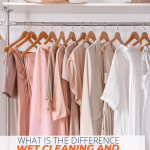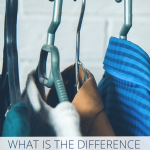What is the difference between wet cleaning and dry cleaning? We get asked this question a lot. Being experts in textile chemistry, wet cleaning, and dry cleaning operations, we’re here to share some of our expertise. In this article, we offer a simplified explanation of the two processes so you can see how they’re different and help make a decision on which is best.

What is wet cleaning?
Wet cleaning is a procedure for the professional cleaning of textiles in water without using organic solvents. Created in the Kreussler Labs in Wiesbaden, Germany, professional wet cleaning was ground-breaking innovation in the professional textile care industry.
Sensitive, even non-washable textiles which are labeled as dry clean only or with the care symbol circle with a P or F inside are cleaned in water at low level with washing mechanics using intervals of short mechanical impulses and longer soaking times. Kreussler’s LANADOL products protect the fabrics against shrinkage, reduce the swelling tendency of natural fibers, and reduce friction by the use of special protein-based surfactants. Very high g-force extractions in specially designed machines safely remove the maximum amount of water without stress to the garments.
We are utilizing smart drying technology to accurately measure the amount of moisture in the fabric and control the drying to perfect levels, all while eliminating friction and reducing energy consumption.
What is dry cleaning?
Dry cleaning is a professional process using solvent, detergents, and special machinery to clean garments that can’t be washed in-home washing machines because of the type of fabric [wool, silk, and viscose] or because it needs special care such as bridal gowns, formal gowns, and suits.
In the past, the most popular option for solvent was perchloroethylene or “perc,” Pec offered many benefits as it is a very good cleaning solvent, dried quickly and is non-flammable/ non-combustible, unlike the only alternative of that time but perc is problematic for the environment. It poses health risks for people exposed to for long periods.
Now there are safer alternative dry cleaning solvents like biobased, sustainable SYSTEMK4 – an earth-friendly dry cleaning system that uses a solvent that is derived from plants, not petroleum, is non-toxic, safe, and cleans better than perc.
In the dry cleaning process, garments are placed in a special programmable machine that regulates the temperature, textile chemistry, and times for the cleaning. Before going into the machine, the garments are checked for stains. Some stains will be pretreated before cleaning the garments. Unlike in professional wet cleaning, where water is the solvent, in dry cleaning, the solvent is mostly effective in removing oily/ greasy stains. Soil that would wash away in wet cleaning needs special attention.
Garments are cleaned and dried in the dry cleaning machine, the process is dry to dry, all in one machine, and the dirty solvent is collected, distilled and purified to be reused for the next load. After the cycle is finished garments are sent for pressing and/or steaming to get them looking perfect.
The dry cleaning process allows for quick and safe cleaning of garments without risk of shrinking or color loss, and before the invention of wet cleaning was the only commercially viable way to process most garments.
When is it best to use wet cleaning or dry cleaning?
Today the choice to wet clean or dry clean a garment mostly falls on personal preference, as both technologies offer safe and sustainable benefits. Garments with high amounts of water-based soil like food, beverages, blood, or sweat will clean much easier in wet cleaning, with less risk associated with localized stain removal. Wet cleaning also offers benefits for anyone sensitive to chemicals as all of Kreussler’s Lanadol products are dermatology tested and certified for the eco-label Blue Angel. In general, whites stay whiter, and colors stay brighter in wet cleaning.
Dry cleaning ensures there is no risk for shrinkage or distortion and provides the quickest way to clean and return a garment. Soil originating from grease and oil respond better to dry cleaning, and for high end structured garments, it makes the most sense to dry-clean them.
What if you’re not sure how to clean a garment?
Many professional dry cleaners offer wet cleaning and dry cleaning in their shops so that they will be able to process any garments their clients bring in. Speak to your local cleaner and see if some of your wardrobe is better suited to one process over the other or if you feel you are more comfortable with one process over the other. Either way, a skilled professional cleaner is your best partner in caring for garments.


